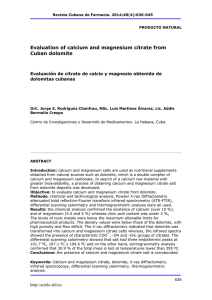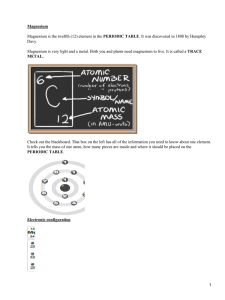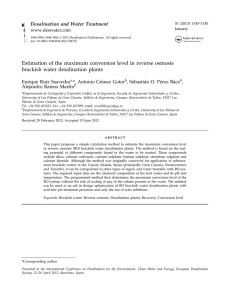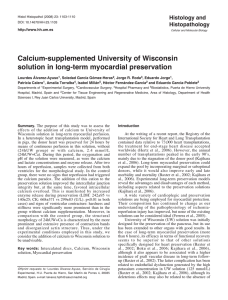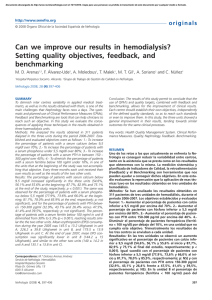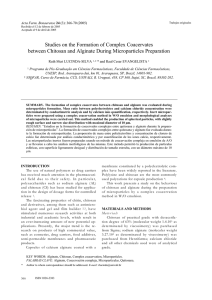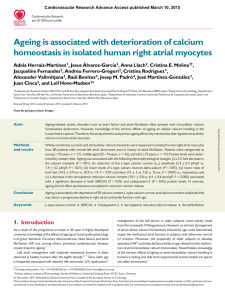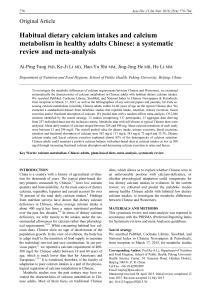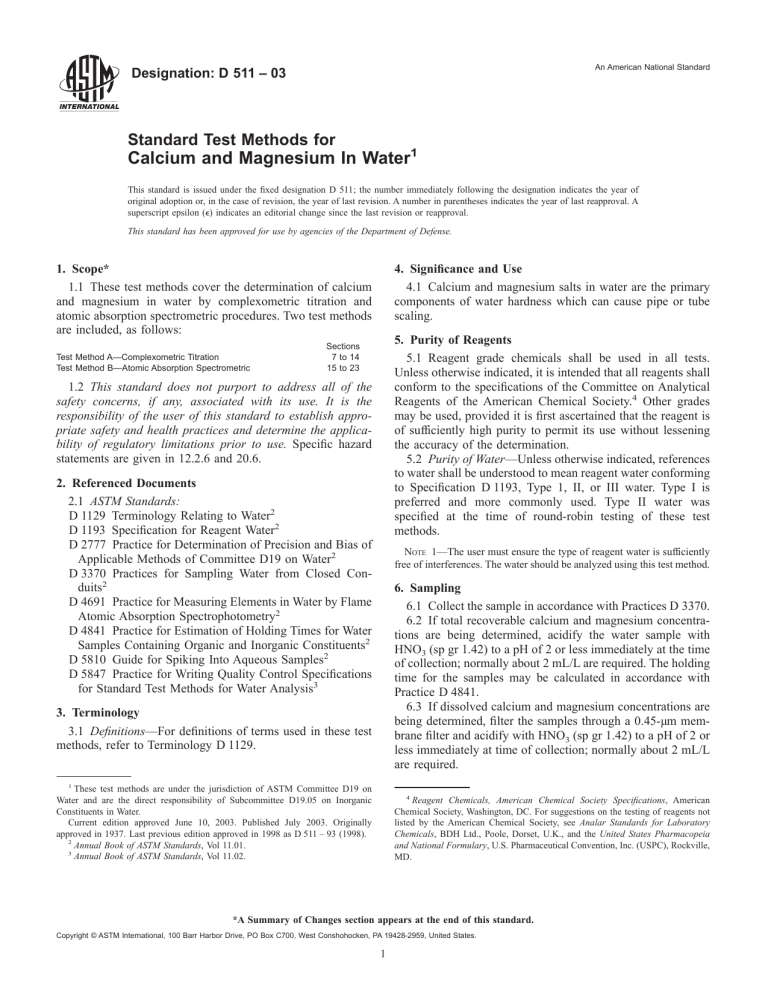
An American National Standard Designation: D 511 – 03 Standard Test Methods for Calcium and Magnesium In Water1 This standard is issued under the fixed designation D 511; the number immediately following the designation indicates the year of original adoption or, in the case of revision, the year of last revision. A number in parentheses indicates the year of last reapproval. A superscript epsilon (e) indicates an editorial change since the last revision or reapproval. This standard has been approved for use by agencies of the Department of Defense. 4. Significance and Use 4.1 Calcium and magnesium salts in water are the primary components of water hardness which can cause pipe or tube scaling. 1. Scope* 1.1 These test methods cover the determination of calcium and magnesium in water by complexometric titration and atomic absorption spectrometric procedures. Two test methods are included, as follows: Test Method A—Complexometric Titration Test Method B—Atomic Absorption Spectrometric 5. Purity of Reagents 5.1 Reagent grade chemicals shall be used in all tests. Unless otherwise indicated, it is intended that all reagents shall conform to the specifications of the Committee on Analytical Reagents of the American Chemical Society.4 Other grades may be used, provided it is first ascertained that the reagent is of sufficiently high purity to permit its use without lessening the accuracy of the determination. 5.2 Purity of Water—Unless otherwise indicated, references to water shall be understood to mean reagent water conforming to Specification D 1193, Type 1, II, or III water. Type I is preferred and more commonly used. Type II water was specified at the time of round-robin testing of these test methods. Sections 7 to 14 15 to 23 1.2 This standard does not purport to address all of the safety concerns, if any, associated with its use. It is the responsibility of the user of this standard to establish appropriate safety and health practices and determine the applicability of regulatory limitations prior to use. Specific hazard statements are given in 12.2.6 and 20.6. 2. Referenced Documents 2.1 ASTM Standards: D 1129 Terminology Relating to Water2 D 1193 Specification for Reagent Water2 D 2777 Practice for Determination of Precision and Bias of Applicable Methods of Committee D19 on Water2 D 3370 Practices for Sampling Water from Closed Conduits2 D 4691 Practice for Measuring Elements in Water by Flame Atomic Absorption Spectrophotometry2 D 4841 Practice for Estimation of Holding Times for Water Samples Containing Organic and Inorganic Constituents2 D 5810 Guide for Spiking Into Aqueous Samples2 D 5847 Practice for Writing Quality Control Specifications for Standard Test Methods for Water Analysis3 NOTE 1—The user must ensure the type of reagent water is sufficiently free of interferences. The water should be analyzed using this test method. 6. Sampling 6.1 Collect the sample in accordance with Practices D 3370. 6.2 If total recoverable calcium and magnesium concentrations are being determined, acidify the water sample with HNO3 (sp gr 1.42) to a pH of 2 or less immediately at the time of collection; normally about 2 mL/L are required. The holding time for the samples may be calculated in accordance with Practice D 4841. 6.3 If dissolved calcium and magnesium concentrations are being determined, filter the samples through a 0.45-µm membrane filter and acidify with HNO3 (sp gr 1.42) to a pH of 2 or less immediately at time of collection; normally about 2 mL/L are required. 3. Terminology 3.1 Definitions—For definitions of terms used in these test methods, refer to Terminology D 1129. 1 These test methods are under the jurisdiction of ASTM Committee D19 on Water and are the direct responsibility of Subcommittee D19.05 on Inorganic Constituents in Water. Current edition approved June 10, 2003. Published July 2003. Originally approved in 1937. Last previous edition approved in 1998 as D 511 – 93 (1998). 2 Annual Book of ASTM Standards, Vol 11.01. 3 Annual Book of ASTM Standards, Vol 11.02. 4 Reagent Chemicals, American Chemical Society Specifications, American Chemical Society, Washington, DC. For suggestions on the testing of reagents not listed by the American Chemical Society, see Analar Standards for Laboratory Chemicals, BDH Ltd., Poole, Dorset, U.K., and the United States Pharmacopeia and National Formulary, U.S. Pharmaceutical Convention, Inc. (USPC), Rockville, MD. *A Summary of Changes section appears at the end of this standard. Copyright © ASTM International, 100 Barr Harbor Drive, PO Box C700, West Conshohocken, PA 19428-2959, United States. 1 D 511 – 03 9.3 In the titration of calcium, ammonium purpurate reacts with strontium but not with magnesium or barium. However, the end point in the presence of strontium is sluggish, and the titration is not strictly stoichiometric. Barium does not titrate as calcium, but affects the indicator in some unknown way so that no end point, or at best a poor end point, is obtained. Barium can be removed by prior precipitation with sulfuric acid, but care must be exercised to prevent precipitation of calcium. Orthophosphate will precipitate calcium at the pH of the test. 9.4 A possible interference from the commonly used polyphosphates, organic phosphonates, and EDTA/NTA compounds in water treatment should be recognized. 6.4 A number of sources of calcium contamination have been encountered in laboratories. Among the most common are plastic ware, paper towels, and dust. Rinsing plastic ware with sample prior to use, avoiding contact of apparatus with paper towels, and keeping exposure to the air to a minimum will limit the possibility of contamination. TEST METHOD A—COMPLEXOMETRIC TITRATION 7. Scope 7.1 This test method is applicable to most waters in a range from 1 to 1000 mg/L of calcium plus magnesium expressed as calcium, but may fail in the analysis of highly colored waters, brines, or waters that contain excessive amounts of metals. The upper and lower limits may be extended by either dilution or use of micro apparatus. 7.2 Data are not available to determine which matrices were used to obtain the precision and bias data, and it is the responsibility of the analyst to determine the acceptability of this test method for the matrix being analyzed. 10. Apparatus 10.1 Titration Assembly—Some analysts prefer to use conventional lighting and hand stirring. Others report better results by using a visual-titration assembly consisting of a motordriven stirrer, 25-mL buret, white-porcelain-base buret holder, and shaded incandescent lamp. The sample beaker is placed near the front of the porcelain base and the reaction is viewed diagonally downward through the side of the beaker and against the white background. Illumination is from behind the beaker. The capacity of the burette, type lighting, and background color may be varied depending on the ionic concentrations normally encountered and the indicator chosen. 8. Summary of Test Method 8.1 EDTA (ethylenediamine tetraacetic acid or its salts) is added to a sample containing calcium and magnesium ions after the pH of the solution is adjusted to 10 for the determination of calcium and magnesium or from pH 12 to 13 for the determination of calcium alone. The EDTA initially complexes the calcium and then the magnesium. The end point is observed by the use of a suitable indicator. At a pH of 12 to 13 magnesium is precipitated. Magnesium is determined by the difference between an aliquot titrated at pH 10 and one titrated at pH 12 to 13. 11. Reagents 11.1 Buffer Solution, Ammonium Chloride-Ammonium Hydroxide—Dissolve 67.6 g of ammonium chloride (NH4Cl) in 200 mL of water. Add 570 mL of concentrated ammonium hydroxide (NH4OH, sp gr 0.900). Add 5.00 g of magnesium salt of EDTA and dilute to 1000 mL. Store in a tightly stoppered plastic bottle to prevent the loss of ammonia. Discard the solution when 1 mL added to a neutralized sample fails to produce a pH of 10.0 6 0.1 at the titration end point. To attain highest accuracy, adjust the magnesium level to exact equivalence through the appropriate addition of a small amount of either disodium EDTA or magnesium sulfate (MgSO4). 11.2 Calcium Indicator Solution: 11.2.1 Ammonium Purpurate—Mix thoroughly 1.0 g of ammonium purpurate with 200 g of sucrose. Place in a bottle provided with a dispensing spoon of 0.2-g capacity. 11.2.2 Fluorescein Methylene Iminodiacetic Acid 5—Grind 0.2 g of fluorescein methylene iminodiacetic acid and 0.12 g of thymolphthalein with 20 g of potassium chloride to 40 to 50 mesh size. Place in a bottle provided with a dispensing spoon of 0.2-g capacity. 11.3 Calcium Solution, Standard (1.00 mL = 0.400 mg calcium)—Suspend 1.000 g of calcium carbonate (CaCO3), dried at 180°C for 1.0 h before weighing, in approximately 600 mL of water and dissolve cautiously with a minimum of dilute HCl. Dilute to 1000 mL with water in a volumetric flask. 11.4 Chrome Black T Solution (4.0 g/L)—Dissolve 0.4 g of Chrome Black T in 100 mL of water. This solution has a shelf life of approximately 1 week. Alternatively, a dry powder 9. Interferences 9.1 EDTA reacts with iron, manganese, copper, zinc, lead, cobalt, nickel, barium, strontium, calcium, magnesium, and several other metals. The interference of heavy metals is minimized by the addition of hydroxylamine and cyanide, which reduce or complex the metals, or both. Metal concentrations as high as 5 mg/L of iron, 10 mg/L of manganese, 10 mg/L of copper, 10 mg/L of zinc, and 10 mg/L of lead can be tolerated when hydroxylamine and cyanide are added. 9.2 In the titration of calcium plus magnesium, the higher oxidation states of manganese above Mn+2 react rapidly with the indicator to form discolored oxidation products. Hydroxylamine hydrochloride reagent is used to reduce manganese to the divalent state. The divalent manganese interference can be eliminated by addition of one or two small crystals of potassium ferrocyanide. 9.2.1 Orthophosphate and sulfate ions interfere at concentrations in excess of 500 and 10 000 mg/L, respectively. 9.2.2 In the presence of aluminum concentrations in excess of 10 mg/L, the blue color that indicates that the end point has been reached will appear and then, on short standing, will revert to red. The reversion should not be confused with the gradual change that normally takes place in the titrated sample several minutes after the titration has been completed. 5 Calcein, W., Fluoroscein Complexon, and Fluorexon, supplied by various commercial firms, have been found satisfactory for this purpose. 2 D 511 – 03 12.1.8 Add 1 mL of buffer solution. Measure the pH and verify that it falls in the pH range from 10.0 + 0.1. 12.1.9 Add 2 mL of NaCN solution (Warning—Sodium cyanide is a deadly poison. Do not add NaCN to any acid solution or acidify any solution containing it. Use this reagent in a fume hood.) 12.1.10 If manganese is present, add one or two small crystals K4Fe(CN)6·3H2O. 12.1.11 Add 4 to 5 drops of Chrome Black T indicator solution. If powdered indicator is used add approximately 0.2 g. 12.1.12 Titrate with standard EDTA solution until blue or purple swirls begin to show. The end point is reached when all traces of red and purple have disappeared and the solution is clear blue in color. The titration should be completed within 5 min of the buffer addition. If more than 15 mL of titrant is required, take a smaller sample aliquot and repeat the test. 12.1.13 Record the volume of EDTA solution required to titrate calcium plus magnesium. 12.1.14 Determine a reagent blank correction by similarly titrating 50 mL of water including all added reagents. 12.2 Calcium: 12.2.1 Refill the burette with EDTA standard solution. 12.2.2 Pipette another aliquot of the same sample (50.00 mL maximum) into a 150-mL beaker and adjust the volume to approximately 50 mL (see Note 4). 12.2.3 Insert the beaker in the titration assembly and start the stirrer. 12.2.4 Add 1 mL of NH2OH·HCl. 12.2.5 Add 1 mL of NaOH solution. The pH should range from 12 to 13. 12.2.6 Add 1 mL of NaCN (Warning—Sodium cyanide is a deadly poison. Do not add NaCN to any acid solution or acidify any solution containing it. Use this reagent in a fume hood.). 12.2.7 Add 0.2 g of calcium indicator solution and proceed immediately with the titration. 12.2.8 Titrate with standard EDTA solution to the appropriate end point. If ammonium purpurate is used, the end point will be indicated by color change from salmon pink to orchid purple. If fluorescein methylene iminodiacetic acid is used, the end point will be indicated by a color change from deep green to purple. The titration should be completed within 5 min of the addition of NaOH solution. If more than 15 mL of titrant is required, take a smaller sample aliquot and repeat the test. 12.2.9 Record the volume of EDTA solution required to titrate the calcium. 12.2.10 Determine a reagent blank correction by similarly titrating 50 mL of water including all added reagents. mixture composed of 0.5 g of dye and 100 g of powdered sodium chloride may be used. Store this in a dark-colored bottle provided with a dispensing spoon of approximately 0.2-g capacity. The shelf life is at least 1 year. 11.5 EDTA Solution, Standard (0.01 M, 1 mL = 0.401 mg calcium or 0.243 mg manganese)—Dissolve 3.72 g of Na2EDTA dihydrate, which has been dried overnight over H2SO4 in a desiccator, in water and dilute to 1000 mL in a volumetric flask. The reagent is stable for several weeks. Check the titer of the reagent by titrating 25.00 mL of CaCO3 standard solution as described in the procedure for sample analysis. 11.6 Hydroxylamine Hydrochloride Solution (30 g/L)— Dissolve 30 g of hydroxylamine hydrochloride (NH2OH·HCl) in water and dilute to 1000 mL. 11.7 Potassium Ferrocyanide—(K4Fe(CN)6·3H2O). 11.8 Sodium Cyanide Solution (25 g/L)—Dissolve 25 g of sodium cyanide (NaCN) in water and dilute to 1000 mL. (Warning—Sodium cyanide is a deadly poison. Do not add NaCN to any acid solution or acidify any solution containing it. Use this reagent in a fume hood.) 11.9 Sodium Hydroxide Solution (80 g/L)—Dissolve 80 g of sodium hydroxide (NaOH) in 800 mL of water. Cool and dilute to 1000 mL. 12. Procedure 12.1 Calcium Plus Magnesium: 12.1.1 Measure 100.0 mL of a well-mixed acidified sample into a 125-mL beaker or flask. NOTE 2—If only dissolved calcium plus magnesium is to be determined, omit 12.1.1 and proceed to 12.1.5. 12.1.2 Add 5 mL of hydrochloric acid (HCl, sp gr 1.19) to each sample. 12.1.3 Heat the samples on a steambath or hot plate until the volume has been reduced to 15 to 20 mL, making certain that the samples do not boil. NOTE 3—For samples with high levels of dissolved or suspended matter, the amount of reduction in volume is left to the discretion of the analyst. 12.1.4 Cool and filter the samples through a suitable filter (such as fine-textured, acid-washed, ashless paper) into 100-mL volumetric flasks. Wash the paper two or three times with water and bring to the volume. 12.1.5 Pipette the filtered sample (50.00-mL maximum) into a 150-mL beaker and adjust the volume to approximately 50 mL. Adjust the pH to 7 to 10 by the dropwise addition of ammonium hydroxide (NH4OH, sp gr 0.900). NOTE 4—For analysis of brines an appropriate aliquot size often can be determined from knowledge of the specific gravity, for example: 1.000 1.025 1.050 1.090 1.120 to to to to to 1.025, 1.050, 1.090, 1.120, 1.180, use use use use use 13. Calculation 13.1 Calculate the concentration of calcium and magnesium in milligrams per litre using Eq 1 and Eq 2: 25 mL 10 mL 5 mL 1 mL 0.1 mL 12.1.6 Insert the beaker in the titration assembly and start the stirrer. 12.1.7 Add 1 mL of NH2OH·HCl solution. Calcium, mg/L 5 ~A 3 B/D! 3 40 100 (1) Magnesium, mg/L 5 ~~C 3 B/E! 2 ~A 3 B/D!! 3 24 300 (2) where: 3 D 511 – 03 A = EDTA standard solution required to titrate calcium in 12.2.9 minus the blank correction determined in 12.2.10, mL, B = molarity of EDTA standard solution, C = EDTA standard solution required to titrate calcium plus magnesium in 12.1.13 minus the blank correction determined in 12.1.14, mL, D = sample taken in 12.2.2, mL, and E = sample taken in 12.1.5, mL. 13.2 If the concentration of strontium is determined to be significant, make a correction for strontium concentration using Eq 3: where: ST = overall precision, SO = single-operator precision, and X = determined concentration of magnesium, mg/L. 14.6 Bias—Recoveries of known amounts of magnesium using this test method were as follows: Corrected mg/L calcium 5 mg/L calcium 2 ~mg/L strontium 3 0.46! 14.7 This information was derived from round-robin testing in which four laboratories, including eight operators, participated. No data were rejected. Four sample levels were run on each of three days. The method of “least squares” was used to determine the precision statements. 14.8 The single-operator precision for calcium determined for synthetic sodium chloride brines having the composition listed in Table 1 is as follows: Amount Added, mg/L 2.38 14.7 22.2 35.9 (3) 13.3 Results for calcium and magnesium may be represented as CaCO3 using Eq 4 and Eq 5: Calcium ~as CaCO3!, mg/L 5 mg/L Ca 3 2.50 (4) Magnesium ~as CaCO3!, mg/L 5 mg/L Mg 3 4.12 (5) 14. Precision and Bias ST 5 0.006 X 1 0.62 (6) SO 5 0.006 X 1 0.51 (7) Statistically Significant, 95 % Confidence Level no no no no For magnesium, it is: SO 5 51 14.9 These data may not apply to waters of other matrices. 14.10 Four independent laboratories participated in the round-robin study. 14.11 This section of precision and bias conforms to Practice D 2777–77, which was in place at the time of collaborative testing. Under the allowances made in 1.4 of D 2777–98, these precision and bias data do meet existing requirements of interlaboratory studies of Committee D19 test methods. where: ST = overall precision, SO = single-operator precision, and X = determined concentration of calcium, mg/L. 14.3 Bias—Recoveries of known amounts of calcium using this test method were as follows: Amount Found, mg/L 13.5 43.0 87.7 Bias, % +6.7 +2.0 −1.8 +0.6 SO 5 76 6 14.1 Data are not available to determine which matrices were used to obtain precision and bias data. 14.2 The precision of this test method for calcium, ranging in calcium concentration between 13 and 88 mg/L, may be expressed using Eq 6 and Eq 7: Amount Added, mg/L 13.3 41.8 84.6 Amount Found, mg/L 2.54 15.0 21.8 36.1 Bias, % +1.5 +2.9 +3.7 15. Quality Control 15.1 In order to be certain that analytical values obtained using these test methods are valid and accurate within the confidence limits of the test, the following QC procedures must be followed when analyzing calcium and magnesium in water. 15.2 Calibration and Calibration Verification 15.2.1 Analyze at least three working standards containing concentrations of calcium and magnesium in water that bracket the expected sample concentration, prior to analysis of samples, to calibrate the instrument. The calibration correlation coefficient should be equal to or greater than 0.990. In addition to the initial calibration blank, a calibration blank shall be analyzed at the end of the batch run to ensure contamination was not a problem during the batch analysis. Statistically Significant, 95 % Confidence Level no yes yes 14.4 This information was derived from round-robin testing in which four laboratories, including eight operators, participated. No data were rejected. Four sample levels were run on each of three days, but one level was rejected as having grossly deteriorated in shipment. The method of “least squares” was used to determine the precision statements. 14.5 The precision of this test method for magnesium ranging in magnesium concentration from between 2.5 and 36 mg/L may be expressed using Eq 8 and Eq 9: ST 5 0.017 X 1 0.85 (8) SO 5 0.002 X 1 0.70 (9) TABLE 1 Composition of Synthetic Sodium Chloride Component NaCl Ba Sr Mg Ca 6 Supporting data have been filed at ASTM International Headquarters and may be obtained by requesting Research Report RR: D19–1027. 4 Brine Test Solutions (All Concentrations, mg/L) 30 1 1 1 2 000 000 000 200 500 50 1 1 5 12 000 000 000 000 000 100 1 1 7 15 000 000 000 000 000 150 1 1 10 25 000 000 000 000 000 D 511 – 03 15.6.2 The spike concentration plus the background concentration of calcium and magnesium in water must not exceed the high calibration standard. The spike must produce a concentration in the spiked sample that is two to five times the analyte concentration in the unspiked sample, or 10 to 50 times the detection limit of the test method, whichever is greater. 15.6.3 Calculate the percent recovery of the spike (P) using the following formula: 15.2.2 Verify instrument calibration after standardization by analyzing a standard at the concentration of one of the calibration standards. The concentration of a mid-range standard should fall within 615 % of the known concentration. 15.2.3 If calibration cannot be verified, recalibrate the instrument. 15.3 Initial Demonstration of Laboratory Capability 15.3.1 If a laboratory has not performed the test before, or if there has been a major change in the measurement system, for example, a new analyst, new instrument, and so forth, a precision and bias study must be performed to demonstrate laboratory capability. 15.3.2 Analyze seven replicates of a standard solution prepared from an Independent Reference Material containing a mid-range concentration of calcium and magnesium in water. The matrix and chemistry of the solution should be equivalent to the solution used in the collaborative study. Each replicate must be taken through the complete analytical test method including any sample preservation and pretreatment steps. The replicates may be interspersed with samples. 15.3.3 Calculate the mean and standard deviation of the seven values and compare to the acceptable ranges of bias in Table 2. If a concentration other than the recommended concentration is used, refer to Practice D 5847 for information on applying the F test and t test in evaluating the acceptability of the mean and standard deviation. 15.4 Laboratory Control Sample (LCS) 15.4.1 To ensure that the test method is in control, analyze an LCS containing a known concentration of calcium and magnesium in water with each batch or ten samples. If large numbers of samples are analyzed in the batch, analyze the LCS after every ten samples. The laboratory control samples for a large batch should cover the analytical ranger when possible. The LCS must be taken through all of the steps of the analytical method including sample preservation and pretreatment. The result obtained for a mid-range LCS should fall within 615 % of the known concentration. 15.4.2 If the result is not within these limits, analysis of samples is halted until the problem is corrected, and either all the samples in the batch must be reanalyzed, or the results must be qualified with an indication that they do not fall within the performance criteria of the test method. 15.5 Method Blank 15.5.1 Analyze a reagent water test blank with each batch. The concentration of calcium and magnesium in water found in the blank should be less than 0.5 times the lowest calibration standard. If the concentration of calcium and magnesium in water is found above this level, analysis of samples is halted until the contamination is eliminated, and a blank shows no contamination at or above this level, or the results must be qualified with an indication that they do not fall within the performance criteria of the test method. 15.6 Matrix Spike (MS) 15.6.1 To check for interferences in the specific matrix being tested, perform an MS on at least one sample from each batch by spiking an aliquot of the sample with a known concentration of calcium and magnesium in water and taking it through the analytical method. P5 100 [A~Vs 1 V! – BVs# CV (10) where: A = Analyte Concentration (mg/L) in Spiked Sample B = Analyte Concentration (mg/L) in Unspiked Sample C = Concentration (mg/L) of Analyte in Spiking Solution Vs = Volume (mL) of Sample Used V = Volume (mL) added with Spike 15.6.4 The percent recovery of the spike should fall within the limits, based on the analyte concentration, listed in Guide D5810, Table 1. If the percent recovery is not within these limits, a matrix interference may be present in the sample selected for spiking. Under these circumstances, one of the following remedies must be employed: the matrix interference must be removed, all samples in the batch must be analyzed by a test method not affected by the matrix interference, or the results must be qualified with an indication that they do not fall within the performance criteria of the guide. NOTE 5—Acceptable spike recoveries are dependent on the concentration of the component of interest. See Guide D 5810 for additional information. 15.7 Duplicate 15.7.1 To check the precision of sample analyses, analyze a sample in duplicate with each batch. If the concentration of the analyte is less than five times the detection limit for the analyte, a matrix spike duplicate (MSD) should be used. 15.7.2 Calculate the standard deviation of the duplicate values and compare to the precision in the collaborative study using an F test. Refer to 6.4.4 of Practice D 5847 for information on applying the F test. 15.7.3 If the result exceeds the precision limit, the batch must be reanalyzed or the results must be qualified with an indication that they do not fall within the performance criteria of the test method. 15.8 Independent Reference Material (IRM) 15.8.1 In order to verify the quantitative value produced by the test method, analyze an Independent Reference Material (IRM) submitted as a regular sample (if practical) to the laboratory at least once per quarter. The concentration of the IRM should be in the concentration mid-range for the method chosen. The value obtained should fall within the control limits established by the laboratory. TEST METHOD B—ATOMIC ABSORPTION SPECTROPHOTOMETRIC 16. Scope 16.1 This test method can be used to determine the concentration of calcium and magnesium in water. The determination 5 D 511 – 03 20.4 Potassium Solution (2 % K)—Dissolve 38.1 g of potassium chloride (KCl) in water and dilute to 1 L. 20.5 Oxidant: 20.5.1 Air, which has been cleaned and dried through a suitable filter to remove oil, water, and other foreign substances, is the usual oxidant. 20.5.2 Nitrous Oxide, medical grade is satisfactory. 20.6 Fuel: Acetylene—Standard, commercially available acetylene is the usual fuel. Acetone, always present in acetylene cylinders, can be prevented from entering and damaging the burner system by replacing a cylinder which has only 50 psig (345 kPa) of acetylene remaining. (Warning—Purified grade acetylene containing a special proprietary solvent rather than acetone should not be used with poly(vinyl chloride) tubing as weakening of the tubing walls can cause a hazardous situation.) of these ions in brackish water, sea water, and brines requires the use of the method of additions described in Section 22. 16.2 This test method is applicable for calcium concentrations in the range from 1.0 to 15 mg/L and magnesium concentrations from 0.25 to 3.5 mg/L. The upper limits can be increased to 1500 mg/L calcium and 350 mg/L magnesium by proper single dilution technique. Serial dilution technique should be used to further extend the limit. 16.3 The precision and bias were obtained on reagent water (1 % HCl). It is the responsibility of the analyst to determine the acceptability of this test method when analyzing untested matrices. 17. Summary of Test Method 17.1 Calcium and magnesium are determined by atomic absorption spectrophotometry. The sample is aspirated following dilution and addition of interference-suppressing solution. 21. Calibration 21.1 Prepare at least four standard solutions containing 1 % La if the air-acetylene-flame is used, or 0.2 % K if the nitrous oxide flame is used, to bracket the expected calcium or magnesium concentration range. Make all dilutions with HCl (1+99). Prepare the standards each time the test is to be performed and select concentrations to give zero, middle, and maximum points for the analytical curve. 21.2 Set the wavelength of the instrument to 422.7 nm for calcium or 285.2 nm for magnesium by atomizing a standard (see Note 6). 21.3 Atomize standards and record the instrument readings in absorbance units. Atomize water between each standard. 21.4 Prepare an analytical curve by plotting on linear graph paper the absorbance versus concentration for each standard, or calculate a standard curve. Alternatively, read concentration directly if provided on instrument. 18. Interferences 18.1 Calcium and magnesium are subject to phosphate and aluminum interference, respectively. The addition of lanthanum in the procedure eliminates the interference effect of up to 600 mg/L of phosphate and 100 mg/L of aluminum. The use of a nitrous oxide-acetylene flame has been reported to remove chemical interferences completely when used with the addition of potassium to control ionization interference. 19. Apparatus 19.1 Atomic Absorption Spectrophotometer for use at 422.7 nm and 285.2 nm for calcium and magnesium, respectively. A general guide for the use of flame absorption applications is given in Practice D 4691. NOTE 6—The manufacturer’s instructions should be followed for all instrumental parameters. Wavelengths other than 422.7 mm and 285.2 mm may be used for calcium and magnesium, respectively, if they have been determined to be equally suitable. 22. Procedure 22.1 If total calcium and magnesium are to be determined, prepare the sample as directed in 12.1.1 through 12.1.4. 22.2 Prepare sample dilutions and add lanthanum solution (5 % La) so that the final concentration of lanthanum in the sample is 1 %. For example, using a 50-mL volumetric flask, add 10 mL of lanthanum solution (5 % La), sample aliquot, and make to volume with HCl (1 + 99). If the nitrous oxide flame is used, omit lanthanum and add potassium solution (2 % K) to yield a final concentration of potassium of 0.2 %. 22.2.1 Method of Additions—For high solids solutions such as sea water or brines, prepare three volumetric flasks, each containing a sample aliquot that will yield approximately 1 mg/L calcium after dilution. To each add lanthanum solution (5 % La) to yield a final concentration of 1 % La (if the nitrous oxide flame is used, omit lanthanum and add potassium solution to yield a final concentration of 0.2 % K), add calcium standard solution to yield 0, 1, and 2 mg/L in the final dilution. 22.2.2 For the magnesium determination prepare three volumetric flasks with sample aliquots to give about 0.1 mg/L magnesium, lanthanum solution (5 % La) to give 1 % La (if the nitrous oxide flame is used, omit lanthanum and add potassium solution to yield a final concentration of 0.2 % K) and 19.1.1 Calcium, Hollow-Cathode Lamp. 19.1.2 Magnesium, Hollow-Cathode Lamp. 19.1.3 Multielement, Hollow-Cathode Lamps. 19.2 For suggested oxidant and fuel used for atomic absorption spectrophotometry, see 20.5 and 20.6. 19.3 Pressure-Reducing Valves—The supplies of fuel and oxidant shall be maintained at pressures somewhat higher than the controlled operating pressure of the instrument by suitable valves. 20. Reagents and Materials 20.1 Calcium Solution, Standard (1 mL = 0.1 mg Ca)— Dilute 250 mL of calcium standard solution (see 11.3) to 1 L with HCl (1+99). 20.2 Lanthanum Solution (5 % La)—Wet 58.7 g of lanthanum oxide (La2O3) with water. Add slowly 250 mL of HCl (sp gr 1.19) to the mixture. When dissolved, dilute to 1 L with water. 20.3 Magnesium Solution, Standard (1 mL = 1.0 mg Mg)— Obtain commercially, or dissolve 1.000 g of magnesium ribbon in a minimum of HCl (1 + 1), and dilute to 1 L with HCl (1 + 99). 6 D 511 – 03 magnesium standard solution to give final concentrations of 0, 0.1, and 0.2 mg/L of magnesium. 22.3 Atomize the samples and record absorbance readings for each. Atomize water between each sample. Amount Added, mg/L 0.26 0.52 1.10 3.20 23. Calculation 23.1 Calculate the concentration of calcium or magnesium in each sample in milligrams per litre obtained from 21.4 and multiply by the dilution factor. 23.2 For sea water and brine samples using the method of additions and assuming a straight line analytical curve for the range of sample dilutions, calculate the concentration of calcium or magnesium in the diluted sample in milligrams per litre using Eq 11: Calcium or magnesium, mg/L 5 A 3 Cstd/~Astd 2 A! SO 5 253 mg/L where: A = absorbance of sample, Astd = absorbance of one of the standard additions, and Cstd = concentration of the same standard addition as Astd, mg/L. Since there are two standard additions, the calculation is made for each and the two results averaged. The concentration of the original water or brine is obtained by multiplying the concentration of the diluted sample by the dilution factor. For magnesium it is: SO 5 31 mg/L 24.7 These data may not apply to waters of other matrices. 24.8 This section on precision and bias conforms to Practice D 2777 – 77, which was in place at the time of collaborative testing. Under the allowances made in 1.4 of D 2777 – 98, these precision and bias data do meet existing requirements of interlaboratory studies of Committee D19 test methods. 24. Precision and Bias 24.1 The precision and bias were obtained on reagent water (1 % HCl). It is the responsibility of the analyst to determine the acceptability of this method for other matrices. 24.2 The overall and single-operator precision for calcium are as in Eq 12 and Eq 13: (12) SO 5 0.002 X 1 0.04 (13) 25. Quality Control 25.1 In order to be certain that analytical values obtained using these test methods are valid and accurate within the confidence limits of the test, the following QC procedures must be followed when analyzing calcium and magnesium in water. 25.2 Calibration and Calibration Verification 25.2.1 Analyze at least three working standards containing concentrations of calcium and magnesium in water that bracket the expected sample concentration, prior to analysis of samples, to calibrate the instrument. The calibration correlation coefficient should be equal to or greater than 0.990. In addition to the initial calibration blank, a calibration blank shall be analyzed at the end of the batch run to ensure contamination was not a problem during the batch analysis. 25.2.2 Verify instrument calibration after standardization by analyzing a standard at the concentration of one of the calibration standards. The concentration of a mid-range standard should fall within 615 % of the known concentration. 25.2.3 If calibration cannot be verified, recalibrate the instrument. 25.3 Initial Demonstration of Laboratory Capability 25.3.1 If a laboratory has not performed the test before, or if there has been a major change in the measurement system, for example, a new analyst, new instrument, and so forth, a precision and bias study must be performed to demonstrate laboratory capability. 25.3.2 Analyze seven replicates of a standard solution prepared from an Independent Reference Material containing a mid-range concentration of calcium and magnesium in ater. The matrix and chemistry of the solution should be equivalent to the solution used in the collaborative study. Each replicate must be taken through the complete analytical test method For magnesium they are as in Eq 14 and Eq 15: ST 5 0.078 X 1 0.03 (14) SO 5 20.001 X 1 0.01 (15) where: ST = overall precision, mg/L, SO = single-operator precision, mg/L, and X = concentration of calcium or magnesium determined, mg/L. NOTE 7—The precision data were obtained using the air-acetylene flame with lanthanum solution addition. The nitrous oxide-acetylene flame with potassium solution addition provides more positive interference removal and is reported to provide equivalent sensitivity. 24.3 Bias—Recoveries of known amounts of calcium using this test method were as follows: Amount Added, mg/L 1.20 3.00 5.00 15.0 Amount Found, mg/L 1.21 3.02 5.02 14.8 Bias, % +0.83 +0.67 +0.40 −1.33 Bias, % −11.5 0 −10.0 −0.63 Statistically Significant, 95 % Confidence Level yes no yes no 24.5 This information was derived from round-robin testing in which seven laboratories, including eight operators, participated. Of eight data sets ranked as described in Practice D 2777, one was rejected as an outlier. Four sample levels were run on each of three days. The method of “least squares” was used to determine the precision statements. 24.6 The single-operator precision for calcium determined on synthetic sodium chloride brines having the composition given in Table 1 is: (11) ST 5 0.036 X 1 0.03 Amount Found, mg/L 0.23 0.52 0.99 3.18 Statistically Significant, 95 % Confidence Level no no no no 24.4 Bias—Recoveries of known amounts of magnesium using this test method were as follows: 7 D 511 – 03 including any sample preservation and pretreatment steps. The replicates may be interspersed with samples. 25.3.3 Calculate the mean and standard deviation of the seven values and compare to the acceptable ranges of bias in Table 2. If a concentration other than the recommended concentration is used, refer to Practice D 5847 for information on applying the F test and t test in evaluating the acceptability of the mean and standard deviation. 25.4 Laboratory Control Sample (LCS) 25.4.1 To ensure that the test method is in control, analyze an LCS containing a known concentration of calcium and magnesium in water with each batch or 10 samples. If large numbers of samples are analyzed in the batch, analyze the LCS after every 10 samples. The laboratory control samples for a large batch should cover the analytical ranger when possible. The LCS must be taken through all of the steps of the analytical method including sample preservation and pretreatment. The result obtained for a mid-range LCS should fall within 615 % of the known concentration. 25.4.2 If the result is not within these limits, analysis of samples is halted until the problem is corrected, and either all the samples in the batch must be reanalyzed, or the results must be qualified with an indication that they do not fall within the performance criteria of the test method. 25.5 Method Blank 25.5.1 Analyze a reagent water test blank with each batch. The concentration of calcium and magnesium in water found in the blank should be less than 0.5 times the lowest calibration standard. If the concentration of calcium and magnesium in water is found above this level, analysis of samples is halted until the contamination is eliminated, and a blank shows no contamination at or above this level, or the results must be qualified with an indication that they do not fall within the performance criteria of the test method. 25.6 Matrix Spike (MS) 25.6.1 To check for interferences in the specific matrix being tested, perform an MS on at least one sample from each batch by spiking an aliquot of the sample with a known concentration of calcium and magnesium in water and taking it through the analytical method. 25.6.2 The spike concentration plus the background concentration of calcium and magnesium in water must not exceed the high calibration standard. The spike must produce a concentration in the spiked sample that is two to five times the analyte concentration in the unspiked sample, or 10 to 50 times the detection limit of the test method, whichever is greater. 25.6.3 Calculate the percent recovery of the spike (P) using the following formula: P5 100 [A~Vs 1 V! – BVs# CV (16) where: A = Analyte Concentration (mg/L) in Spiked Sample B = Analyte Concentration (mg/L) in Unspiked Sample C = Concentration (mg/L) of Analyte in Spiking Solution Vs = Volume (mL) of Sample Used V = Volume (mL) added with Spike 25.6.4 The percent recovery of the spike should fall within the limits, based on the analyte concentration, listed in Guide D5810, Table 1. If the percent recovery is not within these limits, a matrix interference may be present in the sample selected for spiking. Under these circumstances, one of the following remedies must be employed: the matrix interference must be removed, all samples in the batch must be analyzed by a test method not affected by the matrix interference, or the results must be qualified with an indication that they do not fall within the performance criteria of the guide. NOTE 8—Acceptable spike recoveries are dependent on the concentration of the component of interest. See Guide D 5810 for additional information. 25.7 Duplicate 25.7.1 To check the precision of sample analyses, analyze a sample in duplicate with each batch. If the concentration of the analyte is less than five times the detection limit for the analyte, a matrix spike duplicate (MSD) should be used. 25.7.2 Calculate the standard deviation of the duplicate values and compare to the precision in the collaborative study using an F test. Refer to 6.4.4 of Practice D 5847 for information on applying the F test. 25.7.3 If the result exceeds the precision limit, the batch must be reanalyzed or the results must be qualified with an indication that they do not fall within the performance criteria of the test method. 25.8 Independent Reference Material (IRM) 25.8.1 In order to verify the quantitative value produced by the test method, analyze an Independent Reference Material (IRM) submitted as a regular sample (if practical) to the laboratory at least once per quarter. The concentration of the IRM should be in the concentration mid-range for the method chosen. The value obtained should fall within the control limits established by the laboratory. 26. Keywords 26.1 atomic absorption; calcium; complexometric; magnesium; spectrophotometry; titration; water 8 D 511 – 03 SUMMARY OF CHANGES Committee D19 has identified the location of selected changes to this standard since the last issue (D 511 – 93 (1998)) that may impact the use of this standard. (1) Sections 14.11 and 24.8 were added. (2) QC Sections 15 and 25 were added. (3) All sections after Section 14 were renumbered. ASTM International takes no position respecting the validity of any patent rights asserted in connection with any item mentioned in this standard. Users of this standard are expressly advised that determination of the validity of any such patent rights, and the risk of infringement of such rights, are entirely their own responsibility. This standard is subject to revision at any time by the responsible technical committee and must be reviewed every five years and if not revised, either reapproved or withdrawn. Your comments are invited either for revision of this standard or for additional standards and should be addressed to ASTM International Headquarters. Your comments will receive careful consideration at a meeting of the responsible technical committee, which you may attend. If you feel that your comments have not received a fair hearing you should make your views known to the ASTM Committee on Standards, at the address shown below. This standard is copyrighted by ASTM International, 100 Barr Harbor Drive, PO Box C700, West Conshohocken, PA 19428-2959, United States. Individual reprints (single or multiple copies) of this standard may be obtained by contacting ASTM at the above address or at 610-832-9585 (phone), 610-832-9555 (fax), or [email protected] (e-mail); or through the ASTM website (www.astm.org). 9
